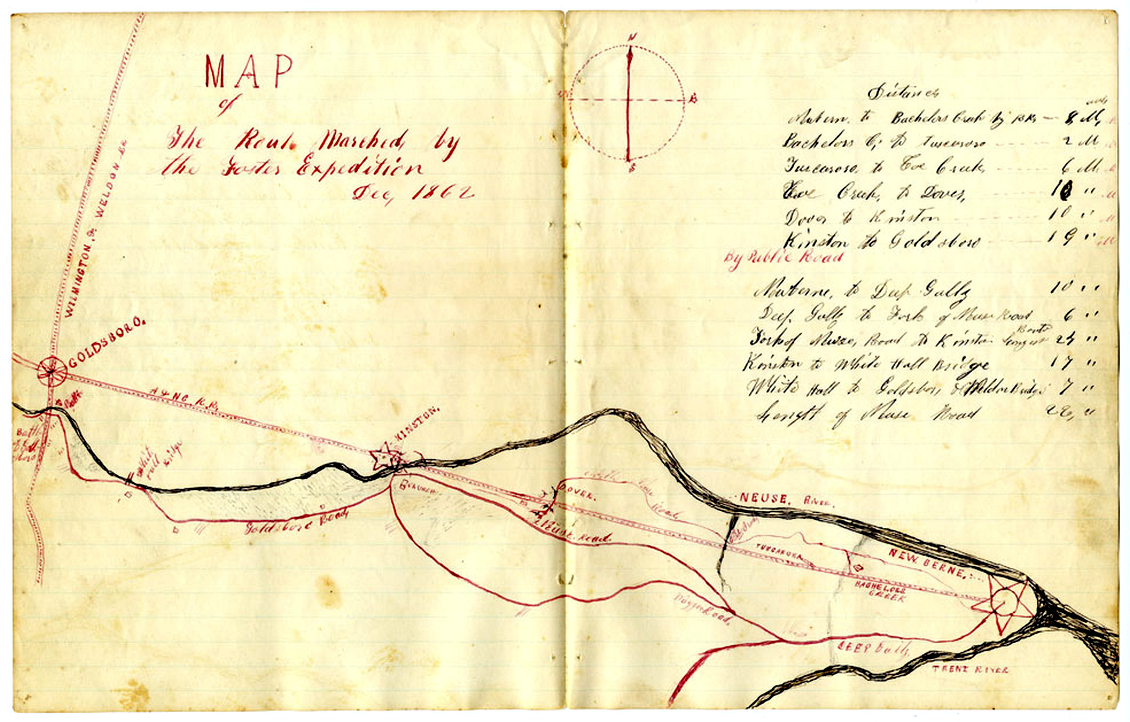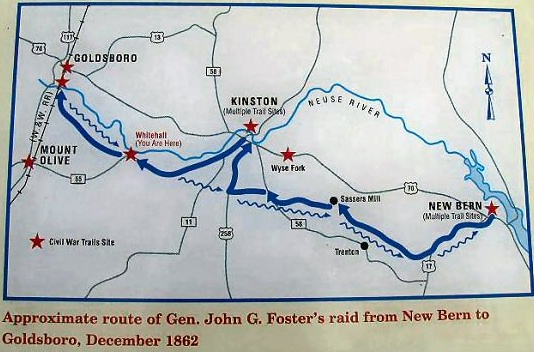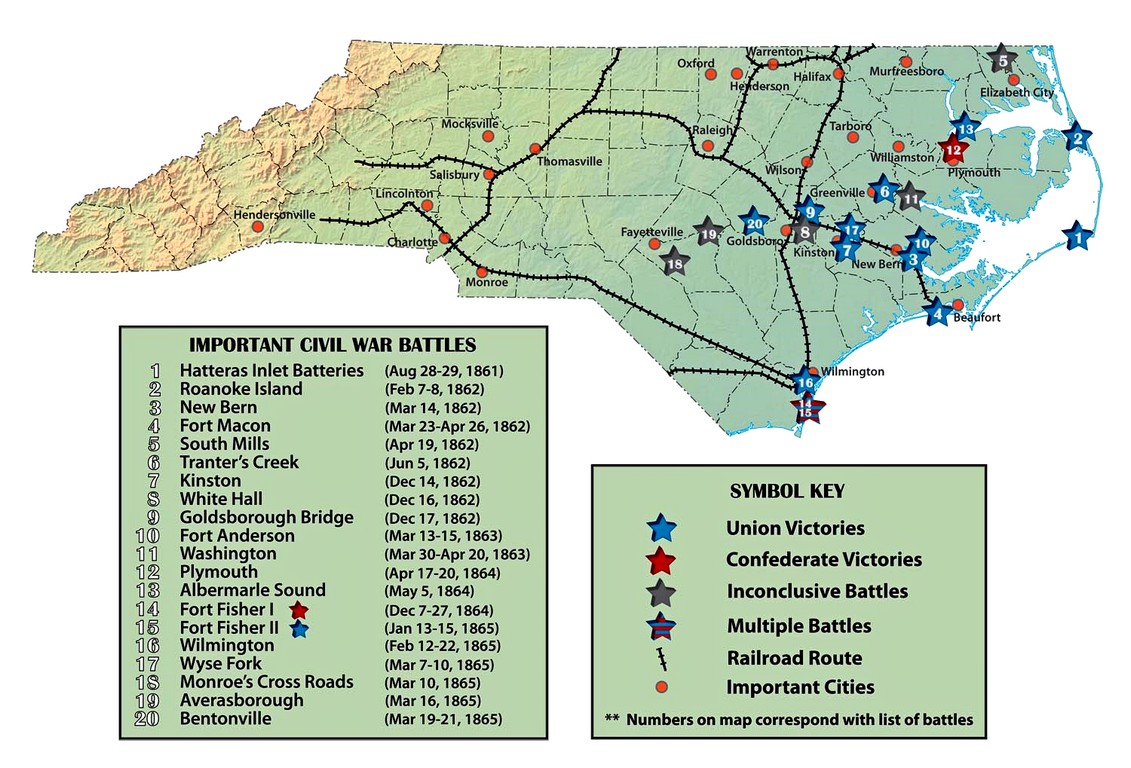|
Goldsboro Expedition, aka Goldsborough Expedition [December
1862]
Introduction
During the American Civil War (186-1865), Union Gen. John G. Foster led
10,000 infantry and cavalry from the Federal garrison at New Bern, North Carolina, on a raid to the Wilmington and Weldon
Railroad near Goldsboro. The action was designed to disrupt the supply line to the north and support Gen. Ambrose Burnside's
attack at Fredericksburg, Virginia (ultimately ill-fated).
Also known as Foster's Raid, the Goldsboro Expedition in December 1862 was a series of battles initiated by Union General John G.
Foster from New Bern to Goldsboro, with military objectives of destroying the railroads, depots, and vital
Goldsboro Bridge. The Goldsboro Expedition (named Goldsborough at the time) was also important because
it demonstrated that the Union forces had the ability to advance from the North Carolina coast, through eastern
North Carolina, and thrust inland to the vital and strategic railroads at Goldsborough. It was an omen of things
to come.
History
In December 1862, with the Civil War in its second year, Brig. Gen. John
G. Foster, the Union commander at New Bern, organized a large overland raid to Goldsboro to coincide with Maj. Gen. Ambrose
E. Burnside's attack on Gen. Robert E. Lee's position at Fredericksburg, Va. The two Union commanders thus intended to prevent
either Confederate force from reinforcing the other. The object of Foster's raid was to destroy the Wilmington & Weldon
Railroad bridge over the Neuse River at Goldsboro, thus severing the rail line that was shipping valuable supplies from the
port at Wilmington to Virginia.
On 11 Dec. 1862 Foster set out with 10,000 infantrymen, 640 cavalrymen,
and 40 artillery pieces. At Kinston, he deployed his force to approach the town from an unanticipated direction on 13 December.
A Confederate regiment briefly defended a partially destroyed bridge over a tributary of the Neuse River and then retreated
to the main Confederate line two miles south of the bridge. Early on the morning of 14 December, Foster attacked the well-chosen
Confederate position, outnumbering the enemy by more than five to one. The left side of the Confederate line collapsed and
retreated across the bridge, mistakenly setting fire to it before the rest of their comrades could cross it. Consequently,
400 southerners were trapped and captured. Foster's men crossed the river and entered Kinston, the defenders retreating before
them. Meanwhile, Burnside had met with a bloody repulse at Fredericksburg.
| Goldsboro Expedition Map |

|
| Civil War Era Goldsboro Expedition Map |
(About) Map of The Route Marched by the Foster Expedition Dec, 1862”
Newton Wallace, Company I, 27th Massachusetts Infantry, drew this map of the route the Foster expedition took through eastern
North Carolina, moving from New Bern to Goldsboro in December 1862. It includes towns, railroads, roads, water features, and
a list of distances traveled. The Battle of Goldsboro Bridge (sometimes spelled “Goldsborough” Bridge), noted
on the left-hand side of the map, took place on 17 December 1862. Courtesy North Carolina Collection, Wilson Library, UNC
Chapel Hill.
On the morning of 15 December, Foster recrossed the river and advanced westward,
stopping for the night four miles outside of Whitehall (now Seven Springs) and sending a reconnaissance party with artillery
support toward the town. This force encountered Confederate cavalry crossing the bridge over the Neuse River and setting fire
to it. The Union artillery was unlimbered and began shelling the Confederates across the river. Damaged in the bombardment
was the incomplete hull of the CSS Neuse, which was under construction there. Foster's main force arrived on 16 December and
entered the fight, the massed Federal artillery sweeping the north side of the river from a commanding position. But the Confederates
fought stubbornly before retreating at nightfall. On the same morning Foster had sent a detachment of New York cavalrymen
to Mount Olive Station on the Wilmington & Weldon Railroad, where they dismantled a section of track.
After the Battle of Whitehall, Foster continued toward his main objective,
nearing the railroad bridge at Goldsboro early on 17 December. He sent parties to Dudley Station and Everittsville to destroy
railroad property in both locations. He also ordered five regiments to burn the railroad bridge at Goldsboro. Sheer firepower
and weight of numbers forced the defenders on the south side of the river to retreat over a small span near the railroad bridge.
As the Confederates hurried across the river, a Union lieutenant dashed for the bridge to put a torch to it. To prevent any
attempt to save it, Foster trained all of his artillery on the bridge. When the vital bridge appeared to be engulfed in flames,
the Federal soldiers returned to New Bern, believing that they had accomplished their mission.
Although Foster was satisfied with the success of the operation, damage
to the bridge was merely superficial. Within two weeks the railroad was fully operational. The most significant damage from
the raid was to personal property, crops, and livestock.
| The Civil War Goldsboro Expedition Map |

|
| Also known as Foster's Raid (From New Bern to Goldsboro) |
Goldsboro Expedition, aka Goldsborough Expedition [December 1862]
| High Resolution North Carolina Civil War Map |

|
| North Carolina Goldsboro Expedition Map |
(Map courtesy LEARN NC.)
| North Carolina Civil War Map of Battles |

|
| Goldsboro Civil War Battlefield Map |
North Carolina and the Civil War:
Recommended Reading: The Civil War in the Carolinas (Hardcover). Description: Dan Morrill relates the experience of two quite different states bound together in
the defense of the Confederacy, using letters, diaries, memoirs, and reports. He shows
how the innovative operations of the Union army and navy along the coast and in the bays and rivers of the Carolinas
affected the general course of the war as well as the daily lives of all Carolinians. He demonstrates the "total war" for
North Carolina's vital coastal railroads and ports. In
the latter part of the war, he describes how Sherman's operation
cut out the heart of the last stronghold of the South.
The author
offers fascinating sketches of major and minor personalities, including the new president and state governors, Generals Lee,
Beauregard, Pickett, Sherman, D.H. Hill, and Joseph E. Johnston. Rebels and abolitionists, pacifists and unionists, slaves
and freed men and women, all influential, all placed in their context with clear-eyed precision. If he were wielding a needle
instead of a pen, his tapestry would offer us a complete picture of a people at war. Midwest Book Review: The Civil War in the Carolinas by civil war expert and historian
Dan Morrill (History Department, University of North Carolina at Charlotte, and Director of the Charlotte-Mecklenburg Historical
Society) is a dramatically presented and extensively researched survey and analysis of the impact the American Civil War had
upon the states of North Carolina and South Carolina, and the people who called these states their home. A meticulous, scholarly,
and thoroughly engaging examination of the details of history and the sweeping change that the war wrought for everyone, The
Civil War In The Carolinas is a welcome and informative addition to American Civil War Studies reference collections.
Recommended Reading: Ironclads and Columbiads: The Coast (The Civil War in North Carolina)
(456 pages). Description: Ironclads and Columbiads
covers some of the most important battles and campaigns in the state. In January 1862, Union forces began in earnest to occupy
crucial points on the North Carolina coast. Within six months,
Union army and naval forces effectively controlled coastal North Carolina from the Virginia line south to present-day Morehead
City. Continued below...
Union setbacks in Virginia, however, led to the withdrawal of many federal soldiers from North Carolina,
leaving only enough Union troops to hold a few coastal strongholds—the vital ports and railroad junctions. The South
during the Civil War, moreover, hotly contested the North’s ability to maintain its grip on these key coastal strongholds.
Recommended Reading: Storm over Carolina: The Confederate
Navy's Struggle for Eastern North Carolina. Description: The struggle for control of the eastern waters of North Carolina during the War Between the States was a bitter, painful,
and sometimes humiliating one for the Confederate navy. No better example exists of the classic adage, "Too little, too late." Burdened
by the lack of adequate warships, construction facilities, and even ammunition, the South's naval arm fought bravely and even
recklessly to stem the tide of the Federal invasion of North Carolina from the raging Atlantic. Storm Over Carolina is the account of the
Southern navy's struggle in North Carolina waters and it
is a saga of crushing defeats interspersed with moments of brilliant and even spectacular victories. It is also the story
of dogged Southern determination and incredible perseverance in the face of overwhelming odds.
For most of
the Civil War, the navigable portions of the Roanoke, Tar, Neuse, Chowan, and Pasquotank rivers were
occupied by Federal forces. The Albemarle and Pamlico sounds, as well as most of the coastal towns and counties, were also
under Union control. With the building of the river ironclads, the Confederate navy at last could strike a telling blow against
the invaders, but they were slowly overtaken by events elsewhere. With the war grinding to a close, the last Confederate vessel
in North Carolina waters was destroyed. William T. Sherman
was approaching from the south, Wilmington was lost, and the
Confederacy reeled as if from a mortal blow. For the Confederate navy, and even more so for the besieged citizens of eastern
North Carolina, these were stormy days indeed. Storm Over Carolina describes their story, their struggle, their history.
Recommended Reading: The Civil War in North Carolina. Description: Numerous
battles and skirmishes were fought in North Carolina during
the Civil War, and the campaigns and battles themselves were crucial in the grand strategy of the conflict and involved some
of the most famous generals of the war. John Barrett presents the complete story of military engagements across the state,
including the classical pitched battle of Bentonville--involving Generals Joe Johnston and William Sherman--the siege of Fort Fisher, the amphibious
campaigns on the coast, and cavalry sweeps such as General George Stoneman's Raid.
Recommended Reading: Confederate Military History Of North Carolina: North Carolina In
The Civil War, 1861-1865. Description:
The author, Prof. D. H. Hill, Jr., was the son of Lieutenant General Daniel Harvey Hill (North
Carolina produced only two lieutenant generals and it was the second highest rank in the army) and
his mother was the sister to General “Stonewall” Jackson’s wife. In Confederate
Military History Of North Carolina, Hill discusses North Carolina’s massive
task of preparing and mobilizing for the conflict; the many regiments and battalions recruited from the Old North State;
as well as the state's numerous contributions during the war. Continued below...
During Hill's
Tar
Heel State study, the reader begins with
interesting and thought-provoking statistical data regarding the 125,000 "Old
North State" soldiers that fought
during the course of the war and the 40,000 that perished. Hill advances with the Tar Heels to the first battle at Bethel, through numerous bloody campaigns and battles--including North Carolina’s
contributions at the "High Watermark" at Gettysburg--and concludes with Lee's surrender at
Appomattox.
|

